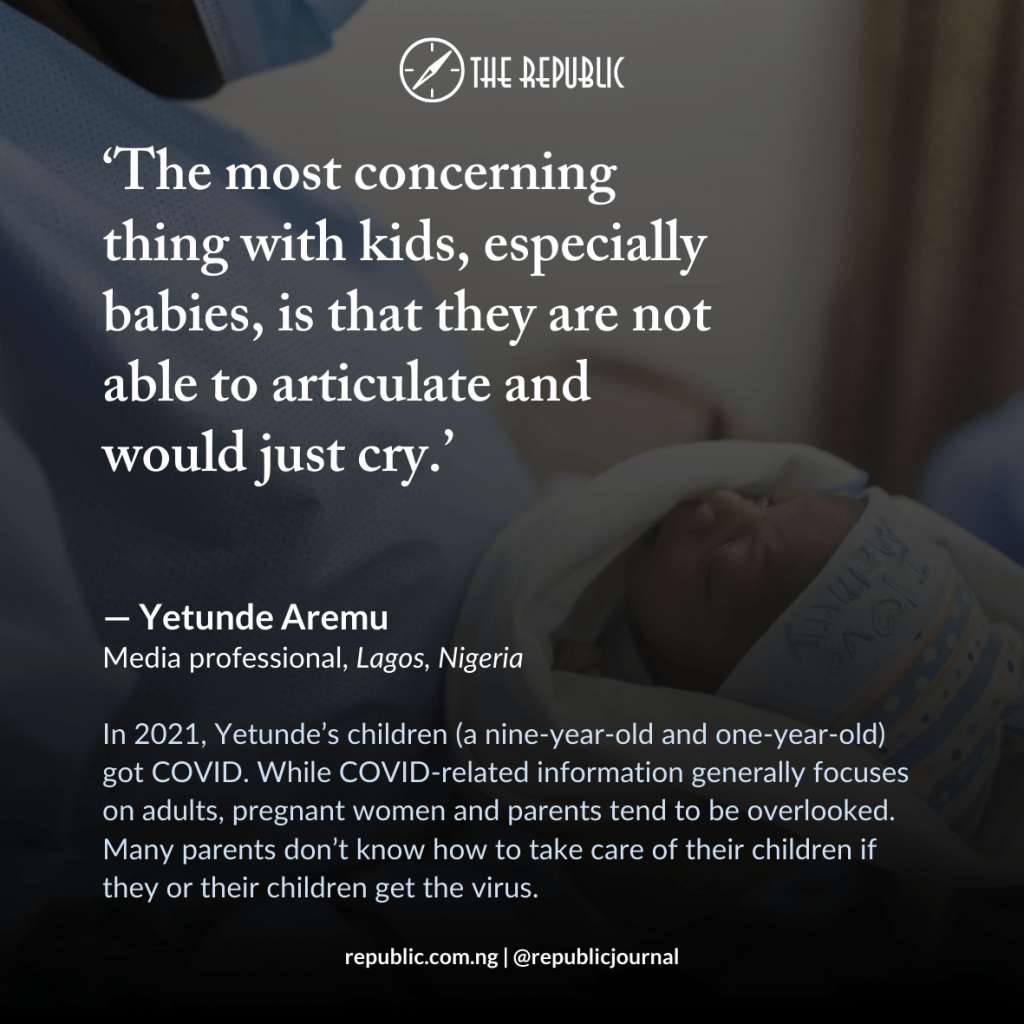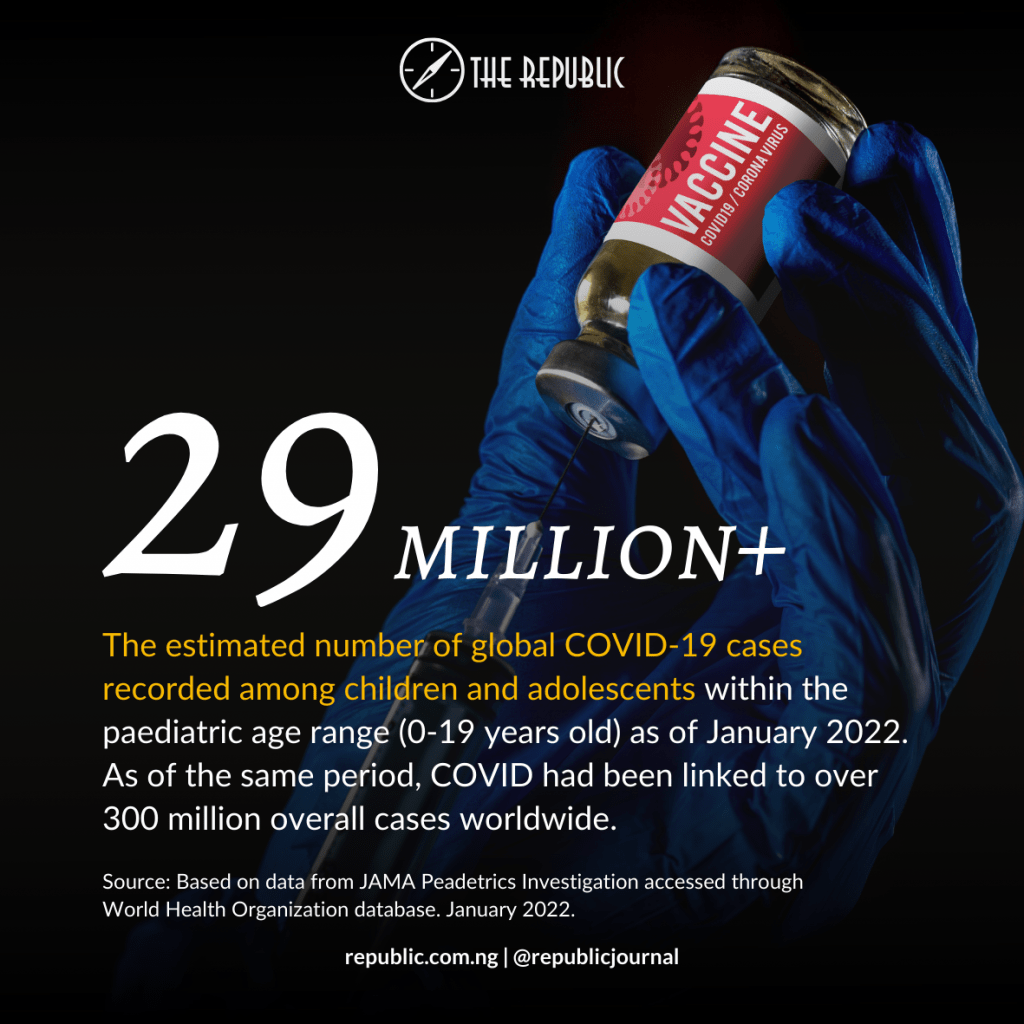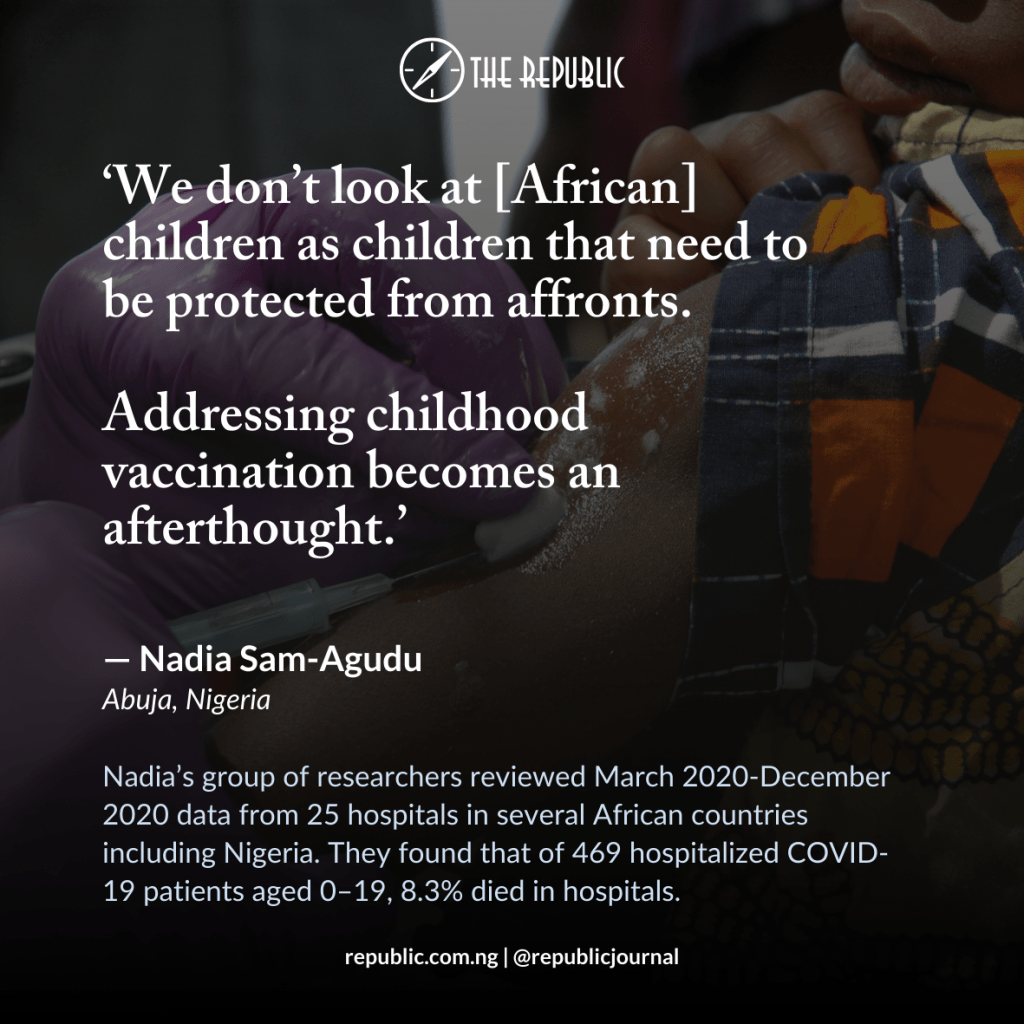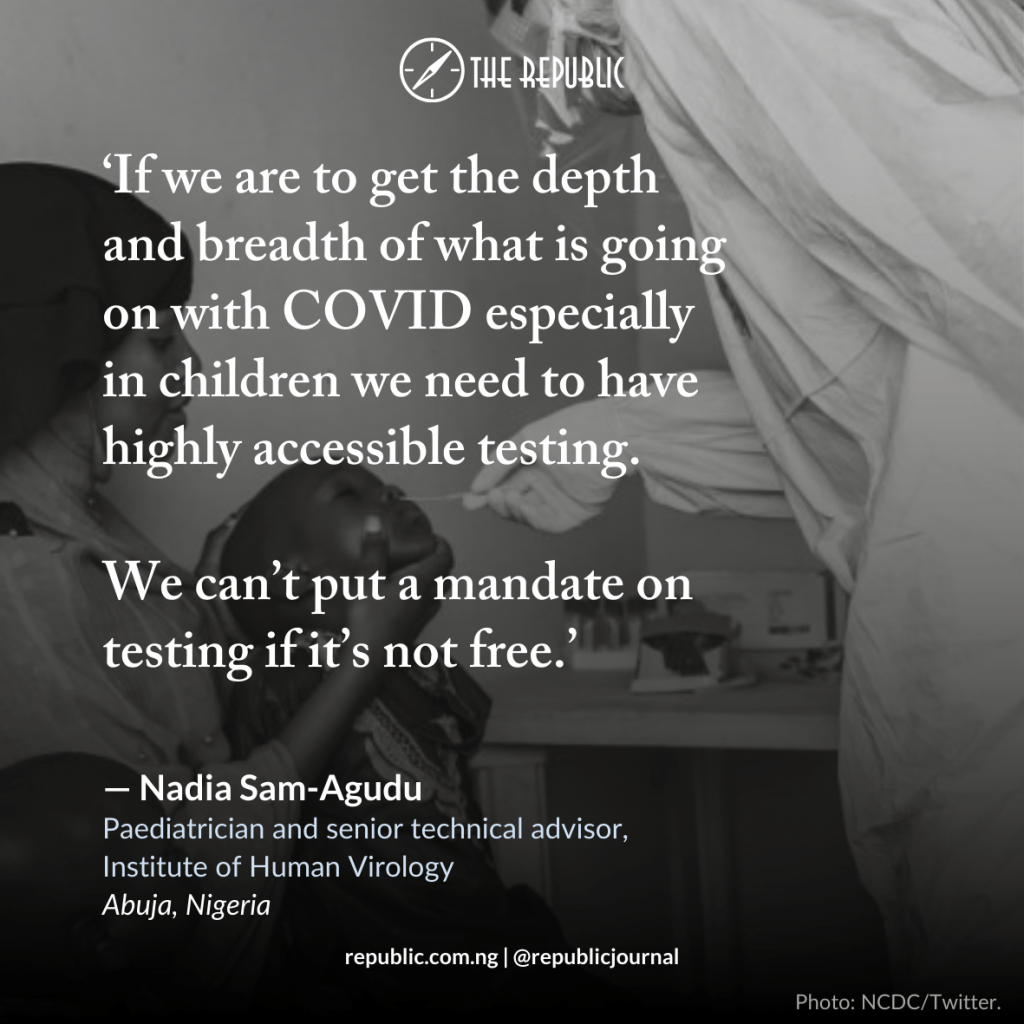Globally, the impacts of COVID-19 on children have been understated. Researchers are now ramping up their focus on the much younger population. But what are the lessons across Africa, where children make up 40% of the population?
Lagos, Nigeria—It came as a surprise to Yetunde Aremu when her husband tested positive for COVID-19 on 20 August 2021. Since they first learned of the pandemic in 2020, Aremu’s family had observed all COVID protocols. They stayed at home, washed their hands frequently and kept their guests at a minimum. Less than a week after her husband, Aremu tested positive. But it didn’t stop there. While recovering in their house in Lekki, their nine-year-old son also tested positive and, soon after, their one-year-old baby had the same results. ‘The most concerning thing with kids, especially babies,’ Aremu said, ‘is that they are not able to articulate and would just cry.’
Earlier in 2021, one of Aremu’s neighbours had died from COVID. Aremu, a media professional, told The Republic, ‘My children know what COVID-19 means and the impact it could have because they knew our neighbour died from complications that arose from COVID.’ But the pandemic has shaped how Aremu and her family now interact with their world. ‘For my nine-year-old, he was very quick to tell me when something was wrong with him,’ she said, adding that, ‘it feels like malaria, but you know that this is more than malaria, it’s not your average malaria, it’s different, there is just more, there is extra.’ Aremu believed it was the most terrifying illness her son had ever had, but it was easier to take care of him than the baby. With the baby, who needed breastfeeding, Aremu’s wondered how to ensure her testing positive did not get in the way of her child’s nutrition.
For nursing mothers like Aremu, a lack of COVID-related information tailored to mothers or children only worsened the dilemma. Temitope Adegbenjo, another recent mother and COVID survivor, got COVID in 2020 just four days after giving birth via C-section. She was isolated at the hospital without access to her child and only reconnected with her child four weeks after she had recovered and tested negative. ‘It felt almost as if I lost the child,’ she said.
Both Aremu and Adegbenjo believed their COVID infections could have been better managed if they had access to tailored information. ‘If I had information available for me at that period,’ Adegbenjo explained, ‘it would have helped me not only pertaining to my health but also manage the whole situation properly.’ Presently, parents lack information on how to take care of their children if they or their children contract the virus. Aremu and Adegbenjo suggested that available information is not always credible and that while most information focuses on adults, pregnant women and parents tend to be overlooked.
COVID-19 has been linked to over 300 million cases and 5 million deaths worldwide, with more than 29 million cases and 22,000 deaths estimated among children and adolescents in the paediatric age range (0-19 years old). Studies have also shown that the severity and impact of the virus are lower in children than adults, with more severity and a higher death rate, especially among those aged 55 and older. As such, some studies have even recommended ‘extra focus’ on the vaccination and treatment of older citizens. With this heightened focus on the older population, what is happening to children, who are increasingly contracting and dying from the virus? Especially in Africa, where children form the majority at 40 per cent of the regional population, what happens when a child gets COVID?
Nadia Sam-Agudu, an Abuja-based paediatrician and senior technical advisor at the Institute of Human Virology, told The Republic that health professionals and the general public tend to be dismissive of African children. A likely reason, she offered, are stereotypes of African children as being resilient and strong or already ‘used’ to diseases. But countries such as Morocco, Guinea, Namibia, and South Africa are starting to vaccinate children as young as 12 against COVID-19, while in Zimbabwe and Egypt children can be vaccinated from as young as 14 and 15, respectively. In Nigeria, only those aged 18 upwards are eligible to receive the vaccine, with the National Primary Health Care Development Agency recently offering a ‘waiver’ for children aged 16 and 17, while specifying that it must be for educational or travel purposes.
The World Health Organization (WHO) has set a global target of a 70 per cent vaccination rate by mid-2022, but only around 10 per cent of Africa’s population is fully vaccinated, and the vaccinated population does not really include children. In South Africa, for instance, less than one per cent of the vaccinated population are children. ‘We don’t look at these children as children that need to be protected from affronts,’ Sam-Agudu said, arguing for an increase in vaccination among children. According to Sam-Agudu, ‘addressing childhood vaccination becomes an afterthought, and a reason is that a lot of decisions in health and health policies centre adults, and usually pregnant women and children are ignored.’
Such ‘exclusive thinking’, as Sam-Agudu described the narrow focus on older COVID patients, typically plays out in how medical institutions understate COVID cases among children. We asked a nurse at the Intensive Care Unit of the Federal Teaching Hospital, Ekiti State about child-COVID cases, and she explained that most children are considered to have chest issues rather than COVID-19. Such children are then treated for symptoms they show. In Lagos, Aremu’s children, for instance, were treated according to what symptoms she could describe to their doctors. Their doctors would then send medications to Aremu’s family at their house. Despite testing positive, the children never visited isolation centres.
Recently, Sam-Agudu was among a group of researchers that reviewed March 2020-December 2020 data from 25 hospitals in the Democratic Republic of the Congo, Ghana, Kenya, Nigeria, South Africa, and Uganda. Their study found that 469 COVID-19 patients aged 0–19 were hospitalized, with ‘about 8.3 per cent of children who were hospitalized with COVID dying in hospitals,’ including 22 of 69 patients who required intensive care unit admission. 89.3 per cent of the hospitalized children were later discharged, and 3.4 per cent remained in the hospital. To Sam-Agudu, these figures were evidence that children are being hospitalized for COVID-19 and dying without adequate care. ‘It’s not something you can say, “Let’s wait for the children,” she said about the hesitance in hospitals to diagnose children with COVID-19, ‘Children need appropriate care, and we need to plan for them.’
Africa’s child population is increasing, with children under 18 accounting for nearly half of the entire region’s population. However, data on COVID-19 cases among children remains scarce. Sam-Agudu disclosed that for her study they had to disregard African countries’ single data system and resort to independent sourcing from the paediatric units at individual hospitals to find information on child cases. They also discovered that children under the age of one were the most affected among child-COVID cases. On sourcing data directly from paediatric units, ‘we shouldn’t have to do that,’ Sam-Agudu said, calling for increased access to testing among children. She explained that COVID testing should be free because more tests will provide a wider pool of available data enabling researchers to better assess levels of impact and spread of the virus among children. ‘If we are to get the depth and breadth of what is going on with COVID, especially in children,’ Sam-Agudu said, ‘we need to have highly accessible testing. And for tests to be highly accessible, the tests need to be free or at a very minimal cost. We can’t put a mandate on testing if it’s not free.’
According to the WHO, six out of every seven people with COVID go undetected because they do not get tested. Sam-Agudu suggested that to drive up testing, institutions such as schools can begin testing at a low cost or for free. However, there are some challenges. For one, many children may be asymptomatic (not showing symptoms of the virus), and this may question the usefulness of testing. ‘But what to do without having to worry about asymptomatic cases is vaccinate,’ Sam-Agudu explained. ‘Vaccinate, so that we reduce the impact on children who may show no symptoms, and children will still go to school safely.’
The Republic reached out to the Nigeria Centre for Disease Control for comments on any plans for vaccinating children in Nigeria, and to clarify issues around insufficient data around COVID-19 and children. The NCDC has not provided any comments⎈
This article was published with the support of the Nigeria Health Watch and the Solutions Journalism Network.
Recommended Reading
Here are some Republic articles to read to learn more about COVID-19 in Africa:
The views, thoughts, and opinions published in The Republic belong solely to the author and are not necessarily the views of The Republic or its editors. We want to hear what you think about this article. Submit a letter to the editors by writing to [email protected].






